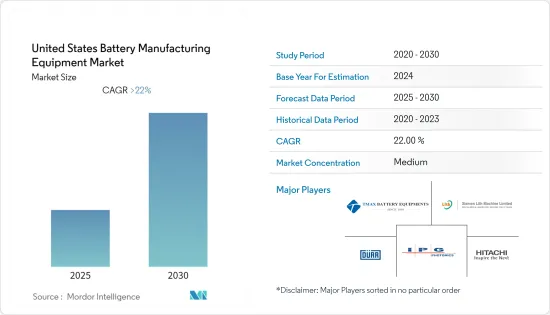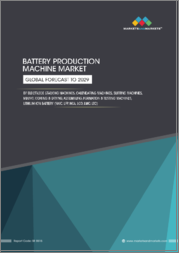
|
시장보고서
상품코드
1635533
미국의 배터리 제조장비 시장 : 점유율 분석, 산업 동향, 성장 예측(2025-2030년)United States Battery Manufacturing Equipment - Market Share Analysis, Industry Trends & Statistics, Growth Forecasts (2025 - 2030) |
||||||
■ 보고서에 따라 최신 정보로 업데이트하여 보내드립니다. 배송일정은 문의해 주시기 바랍니다.
미국의 배터리 제조 장비 시장은 예측 기간 동안 22% 이상의 CAGR로 추이할 전망

주요 하이라이트
- 장기적으로는 배터리 에너지 저장 프로젝트와 함께 재생 가능 에너지 도입 증가라고 하는 요인이 시장을 견인할 것으로 예상됩니다.
- 한편, 경쟁 압력의 상승이나 설비 비용이 시장의 성장을 방해하는 큰 요인이 되고 있습니다.
- 고용량화나 저방전율화 등 다양한 기술의 진보가 진행됨으로써, 배터리 제조 장비의 제조가 보다 실현 가능하고 효율적으로 되어, 배터리 제조 장비 시장에 거대한 비즈니스 기회가 생길 것으로 기대되고 있습니다.
미국 배터리 제조 장비 시장 동향
시장을 독점하는 자동차 부문
- 미국은 이산화탄소 배출량을 줄이려고 노력하고 있습니다. 지속가능한 에너지 프로그램에 따르게 되어, 이것이 이 나라의 배터리 제조 장비 시장을 강화할 것으로 예측되고 있습니다.
- 또한 최근 몇 년동안 미국에서는 전기자동차 수요가 크게 증가하고 있습니다. 2020년에는 29만 4,000대였던 전기자동차가 2021년에는 총 63만대 판매됐습니다.
- 또한 전기자동차 수요가 확대됨에 따라 자동차 제조업체는 자동차 판매량을 늘리기 위해 모든 자동차 카테고리에 대해 다양한 형태와 디자인의 전기자동차를 개발하고 있습니다. 자동차 제조업체의 기대에 부응하는 배터리 제조에 큰 성장 기회를 가져옵니다.
- 게다가 2022년 12월, General Motors와 LG Energy Solution은 테네시주 합작배터리 공장에 2억 7,500만 달러를 추가 투자해 생산량을 40% 이상 늘릴 것이라고 발표했습니다. 합병회사 Ultium Cells LLC는 이 새로운 투자가 2021년 4월에 발표된 280만 평방 피트의 시설을 건설하기 위한 23억 달러에 추가할 것이라고 발표했습니다.
- 따라서, 생산량 증가, 기술의 진보, 배터리 생산에 대한 정부의 지원 시책에 의해 예측 기간에서는 자동차 부문이 시장을 독점할 것으로 예상되어, 배터리 장비 제조 시장을 견인합니다.
신재생에너지 프로젝트 증가와 배터리 에너지 저장 시스템이 시장을 견인할 전망
- 최근 몇 년간 재생 가능 에너지 발전의 설비 용량과 발전량은 미국 전체에서 꾸준히 증가하고 있습니다. 피크 타임에 사용할 에너지를 저장하는 것이 중요합니다. 배터리 에너지 저장 시스템(BESS)은 재생 가능 에너지 프로젝트에 불가결한 것이 되고 있습니다.
- 배터리 에너지 저장은 지속 가능한 에너지 시스템으로의 전환에 중요한 기술로 여겨지고 있습니다. 배터리는 에너지 저장 시스템에서 매우 중요하며 시스템의 총 비용의 약 60%를 차지합니다. 수요가 증가할 것으로 예상됩니다.
- 2021년 미국은 연방 지속가능계획(FSP)을 도입하였습니다. 이 야심찬 목표를 달성하기 위해 에너지성의 국립 실험실인 국립 재생 가능 에너지 실험실(NREL)은 태양광과 풍력에너지원의 대폭적인 증가 를 전망하고 있습니다.
- 미국에너지정보국에 따르면 2021년 미국의 재생가능에너지 생산량은 1경 2,317조 영열단위로 전년대비 5.5% 증가합니다.
- NREL에 따르면 풍력과 태양광 에너지는 2035년까지 전력 믹스에서 적어도 60-80%의 발전량을 공급할 것으로 예상되고 있습니다. 또한 풍력과 태양에너지의 2테라와트를 포함해 2035년에는 발전량 전체가 2020년의 3배로 증가할 것으로 추정됩니다. 이러한 재생가능 에너지 프로젝트 증가는 배터리 축전 시스템 수요를 증가시키고 결과적으로 배터리 수요를 증가시킬 것으로 예상됩니다.
- 예를 들어, 2022년 12월, Mitsubishi Power Americas는 미국 남동부에서 3개의 배터리 에너지 저장 시스템 개발에 배터리를 공급한다고 발표했습니다. 이 3가지 하이브리드 프로젝트는 Origis Energy가 개발한 것으로, 이 지역의 150만kW 운전 및 계약 중인 자산의 일부입니다.
- 따라서 위의 점에서 재생 가능 에너지와 배터리 에너지 저장 시스템의 보급 확대가 미국의 배터리 제조 장비 시장을 견인할 것으로 예상됩니다.
미국 배터리 제조 장비 산업 개요
미국의 배터리 제조 장비 시장은 적당히 분할됩니다. 이 시장의 주요 기업(순부동)으로는 Xiamen Lith Machine Limited, IPG Photonics Corporation, Durr AG, Hitachi, Xiamen Tmax Battery Equipments Limited 등이 있습니다.
기타 혜택
- 엑셀 형식 시장 예측(ME) 시트
- 3개월간의 애널리스트 서포트
목차
제1장 서론
- 조사 범위
- 시장의 정의
- 조사의 전제
제2장 주요 요약
제3장 조사 방법
제4장 시장 개요
- 소개
- 2028년까지 시장 규모와 수요 예측(단위: 10억 달러)
- 최근 동향과 개발
- 정부의 규제와 시책
- 시장 역학
- 성장 촉진요인
- 억제요인
- 공급망 분석
- PESTLE 분석
제5장 시장 세분화
- 기계 유형
- 코팅 및 드라이어
- 캘린더
- 슬릿
- 믹싱
- 전극 스태킹
- 조립 및 핸들링 머신
- 성형·검사기
- 최종 사용자
- 자동차
- 산업용
- 기타
제6장 경쟁 구도
- M&A, 합작사업, 제휴, 협정
- 주요 기업의 전략
- 기업 프로파일
- Xiamen Lith Machine Limited
- Xiamen Tmax Battery Equipments Limited
- IPG Photonics Corporation
- Durr AG
- Hitachi Ltd
- Schuler AG
- Xiamen Acey New Energy Technology Co.,Ltd.
제7장 시장 기회와 앞으로의 동향
JHS 25.01.31The United States Battery Manufacturing Equipment Market is expected to register a CAGR of greater than 22% during the forecast period.

Key Highlights
- Over the long term, factors like the increasing adoption of renewable energy coupled with battery energy storage projects are expected to drive the market.
- On the other hand, rising competitive pressure and equipment costs are significant restraints hindering the market's growth.
- Nevertheless, the increasing technological advancements in various technologies like higher capacity and low discharge rate is expected to make the manufacturing of battery equipment more feasible and efficient and create enormous opportunities for the battery manufacturing equipment market.
US Battery Manufacturing Equipment Market Trends
Automotive Segment to Dominate the Market
- The United States has been attempting to reduce its carbon footprint. To fulfill its emissions target, the country has sanctioned several green programs. Furthermore, public awareness and pressure from numerous stakeholders have weighed in to follow the sustainable energy programs, which are predicted to enhance the country's battery manufacturing equipment market.
- Moreover, in recent years the demand for electric vehicles in the United States has grown significantly. According to International Energy Agency, the number of electric vehicles in the United States increased by 53.33 % in 2021 compared to 2020. In 2021 a total of 630,000 units of electric vehicles were sold, compared to 294,000 in 2020. A similar trend is expected to be followed during the forecast period, which indicates the increasing growth of the battery equipment manufacturing market.
- Additionally, as the demand for electric vehicles grows, automakers are developing electric vehicles of various forms and designs for all car categories to increase vehicle sales. This customization in automotive design presents a substantial growth opportunity for battery manufacturing to fulfill automobile manufacturers' expectations.
- Furthermore, in December 2022, General Motors and LG Energy Solution announced that they would spend an additional USD 275 million on their joint venture battery plant in Tennessee to increase production by more than 40%. The joint venture, Ultium Cells LLC, announced that the new investment is in addition to the USD 2.3 billion announced in April 2021 to build the 2.8 million-square-foot facility. Production at the plant is expected to begin in late 2023.
- Hence, the automobile segment is expected to dominate the market in the forecast period due to increased production, technological advancements, and supportive government policies for battery production, which drives the battery equipment manufacturing market.
Increasing Renewable Energy Projects Coupled with Battery Energy Storage System Expected to Drive the Market
- Over the last few years, installed renewable energy capacity and generation have steadily increased across the United States. Since renewable resources such as solar and wind generate power intermittently and at different levels, storing this energy during peak demand is critical. As a result, battery energy storage systems (BESS) are becoming essential to renewable energy projects. The rapid growth of the renewable energy sector is expected to be one of the country's most potent drivers of battery demand.
- Battery energy storage is considered a critical technology in transitioning to a sustainable energy system. The battery energy storage systems regulate voltage and frequency, reduce peak demand charges, integrate renewable sources, and provide a backup power supply. Batteries are crucial in energy storage systems and are responsible for around 60% of the system's total cost. This increase in BESS projects in the country is expected to increase the demands for batteries in the region.
- In 2021, the United States introduced the Federal Sustainability Plan (FSP), which outlines an ambitious path to power Federal facilities with 100 percent carbon pollution-free electricity (CFE), including 50 percent on a 24-hour-a-day, 7-days-a-week (24/7) basis. In order to achieve this ambitious target, the National Renewable Energy Laboratory (NREL), the national laboratory of the Department of Energy, expects a significant increase in solar and wind energy sources.
- According to the U.S. Energy Information Administration, the United States produced 12,317 trillion British thermal units of renewable energy in 2021, representing a 5.5% increase over the previous year.
- According to NREL, wind and solar energy are expected to provide at least 60 to 80% of power generation in the electricity mix by 2035. It is further estimated that the overall electricity generation will increase by three folds in 2035 compared to 2020, including two terawatts of wind and solar energy sources. This increase in renewable energy projects is expected to increase the demand for battery energy storage system which consequently will increase the demand for batteries.
- For instance, in December 2022, Mitsubishi Power Americas announced that they would supply batteries for the development of three battery energy storage systems in the southeast US. The three hybrid projects are being developed by Origis Energy as part of 1.5 GW of operational and contracted assets in the region.
- Therefore, owing to the above points, the increasing penetration of renewable energy coupled with battery energy storage systems is expected to drive the battery manufacturing equipment market in the United States.
US Battery Manufacturing Equipment Industry Overview
The United States battery manufacturing equipment market is moderately fragmented. Some key players in this market (in no particular order) include Xiamen Lith Machine Limited, IPG Photonics Corporation, Durr AG, Hitachi Ltd, and Xiamen Tmax Battery Equipments Limited., among others.
Additional Benefits:
- The market estimate (ME) sheet in Excel format
- 3 months of analyst support
TABLE OF CONTENTS
1 INTRODUCTION
- 1.1 Scope of the Study
- 1.2 Market Definition
- 1.3 Study Assumptions
2 EXECUTIVE SUMMARY
3 RESEARCH METHODOLOGY
4 MARKET OVERVIEW
- 4.1 Introduction
- 4.2 Market Size and Demand Forecast in USD billion, till 2028
- 4.3 Recent Trends and Developments
- 4.4 Government Policies and Regulations
- 4.5 Market Dynamics
- 4.5.1 Drivers
- 4.5.2 Restraints
- 4.6 Supply Chain Analysis
- 4.7 PESTLE Analysis
5 MARKET SEGMENTATION
- 5.1 Machine Type
- 5.1.1 Coating & Dryer
- 5.1.2 Calendaring
- 5.1.3 Slitting
- 5.1.4 Mixing
- 5.1.5 Electrode Stacking
- 5.1.6 Assembly & Handling Machines
- 5.1.7 Formation & Testing Machines
- 5.2 End User
- 5.2.1 Automotive
- 5.2.2 Industrial
- 5.2.3 Other End Users
6 COMPETITIVE LANDSCAPE
- 6.1 Mergers and Acquisitions, Joint Ventures, Collaborations, and Agreements
- 6.2 Strategies Adopted by Leading Players
- 6.3 Company Profiles
- 6.3.1 Xiamen Lith Machine Limited
- 6.3.2 Xiamen Tmax Battery Equipments Limited
- 6.3.3 IPG Photonics Corporation
- 6.3.4 Durr AG
- 6.3.5 Hitachi Ltd
- 6.3.6 Schuler AG
- 6.3.7 Xiamen Acey New Energy Technology Co.,Ltd.
7 MARKET OPPORTUNITIES AND FUTURE TRENDS
샘플 요청 목록



















